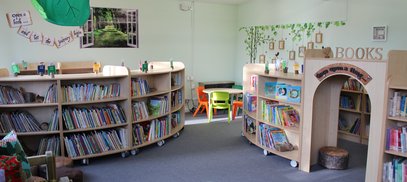The start of a new school year is a great time to try something new to engage even more pupils in the school library. To celebrate Libraries Week 2021, our Reading for Enjoyment Programme Manger, Lucy Starbuck Braidley, has collected ideas from experienced library staff based in schools and public libraries across the country and compiled this handy list of top tips.
Tip 1: Thoughtful displays
When displaying books in your library it’s important to consider the reader carefully. Simple tricks can make it easier for children and young people to find the books that they like. For example, I recommend displaying series of books in the correct order, so that followers of the series can easily find their next read. Making an eye-catching, easy to find feature of books new to the collection is another great way of drawing people in and showing them that the library collection is always changing.
Raksha Agheda, Librarian. Islington
Tip 2: Create a pupil-led recommendation shelf
Ask two children to pick a selection of their favourite books (roughly 10-12 is best). Try to get them to include a range of text types such as poetry, non-fiction, graphic novels, novels and a range of diverse texts too. They select their books and put them on a designated/assigned shelf or display and attach a post it note to the cover that explains why they have chosen it, who might enjoy reading it and a rating. Then after two weeks you get a new pair to choose theirs and keep repeating the cycle.
Richard Ruddick, Year 6 teacher at The Avenue Junior School, Norwich @RuddickRichard
Tip 3: Less is more
Something so simple yet so effective: outward-facing books. This small tweak has made such a difference in our school library, showcasing the front of the books really catches the children's attention. Yes, this takes a little organisation and even a little clear out of old books but what a difference it has made. We no longer cram the shelves full to the brim we choose our books carefully. Quality is key to engaging readers.
Britany Parker, English Lead at Brandling Primary, Gateshead
Tip 4: Showcase popular genres
Know what your children love to read and make a feature of it. This can be as simple as sorting books into genres and positioning your most popular genre in an easily accessible space that is noticeable as soon as you walk in to the library. At Firs Primary, our most popular genre was the humorous books, so I created a LOL section on a swivel shelf. This is one of the first things the children would see when they walked into the library and as it was sectioned off by author and series, children could easily find their favourite titles. Another example of a way you could do this is to have a cosy corner for books that are popular for sharing. I have a corner for graphic novels and comics, which is hugely popular.
Rumena Aktar, Librarian at Firs Primary Academy, Castle Bromwich @rumena_aktar
Tip 5: Go beyond books
Having extracurricular clubs such as Film Club, Dungeons and Dragons, Open Mics and a Maker-space, where students build their own creations, will bring in a large number of students who may not normally use the library. It will also potentially lead to new partnerships with staff in the school.
Involve staff as much as possible: students love to see teachers and staff outside of their ‘normal’ environments. It’s a way to drive home the point that the library is for everyone and that it is a communal, safe space. Seeing a PE teacher recite a poem at a Library Open Mic, or playing Dungeons and Dragons with a maths teacher at lunchtime, creates amazing moments for everyone involved and will help bring both students and staff back to the library again and again.
Lucas Maxwell, Librarian at Glenthorne High School, Sutton @lucasjmaxwell
Tip 6: Read first chapters to pupils
Enthusiasm and knowing your stock well. If you are enthusiastic about children’s fiction and non-fiction, I can almost guarantee children will be swept along with excitement/trepidation, happiness/sadness, in fact, empathy for characters they didn’t even know existed until you opened the book and shared something with them.
I regularly read first chapters to children. This is where the magic happens. It sets the scene of the story, introduces the main characters, makes us care enough (or not as the case may be) to go on a journey with them. In fact, if a book is not ticking all your expectations of a first chapter, do not go any further, leave well alone and venture into another story that catches your eye. Giving children the power to say no thank you and allowing them dip freely in and out of different genres and subjects, allows them to eventually make informed reading choices. The benefits are endless; the adventures they will have over a lifetime, priceless. And all this from enthusiastically introducing a book through chapter one…
Elaine Hallyburton, Service Manager, Children’s Library and Information Services, Dundee @ElaineSLSDundee
We hope you find these tips useful and find the time to try out one or two this Libraries Week!
For more ideas to support reading in your library, explore these reading for enjoyment resources:
- How to choose books you’ll love – this fun animation guides primary-aged children through the process of book selection.
- Brilliant ideas to encourage reading for pleasure – tips and inspiration with a poster to display
- Reading Champions Challenges – termly challenges for ages 5-14 that encourage reading for pleasure as well as developing reading stamina and increasing reading diversity.
